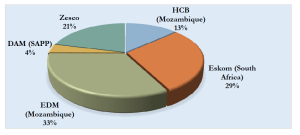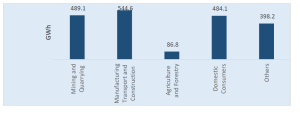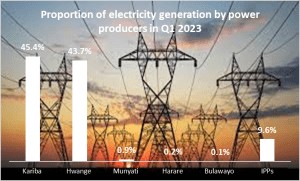

FOR many, life in Zimbabwe is like camping. Due to erratic supplies of pumped water, the precious liquid in most households is stored in containers of various shapes and sizes and meals can either be prepared on firewood or gas stoves.
In a country where years of economic collapse have battered decades-old key infrastructure, society has been socially stratified, but two classes appear to be as clear as daylight — the haves and have-nots. Most locals have found ways to deal with the socio-economic problems.
You find reservoir tanks perched above pre-cast walls and solar panels above rooftops, all to ease blackouts and tap water challenges.
In the country, those who can afford generators and solar panels are managing to cope, but for many, their businesses and livelihoods have been negatively affected, widening the gap between the haves and have-nots.
The southern African country ― with an electrification rate of 53 percent ― has over the past few months been experiencing its worst power crisis on record, with businesses and households having to endure load-shedding of up to 18 hours a day.

Share of electricity imported by source during the first quarter of 2023
The government has since declared an end to power outages following an increase in domestic power generation, after the commissioning of Hwange Units 7 and 8 although some areas are still experiencing load-shedding.
Zimbabwe mainly relies on hydro and thermal energy sources but antiquated electricity infrastructure, decades of non-maintenance, foreign currency shortages, legacy debt, sub-economic tariffs, and climate change-related factors, have led to power generation being supplemented by imports and independent power producers.
Declining water levels at the country’s largest hydropower station in Kariba have resulted in a significant drop in power generation, which has led to power shortages in both Zimbabwe and Zambia. Other smaller power plants built before independence have been mothballed.
The government has committed to transition from fossil fuels to sustainable energy to limit climate change.
Authorities plan to increase the installed renewable energy capacity, excluding large-scale hydropower, to 2 100 megawatts or 26,5 percent of the overall electricity supply by 2030 from five percent.
The intensifying climate emergency, ongoing energy crisis and increasing political uncertainties around the world have been the turning point to accelerate the energy transition among most countries.

Volume of electricity distributed by user in Q123
According to the ministry of Environment, Water and Climate, energy use is the country’s largest source of greenhouse gas emissions.
The National Renewable Energy Policy sees the country’s vast array of clean energy sources including solar, hydro, biomass, geothermal and wind as enough to facilitate a transition from fossil fuels.
As the government moves to bring a strategic shift to the country’s energy mix in line with the UN’s Sustainable Development Goals, households and companies have been adopting renewable energy sources to survive the debilitating power crisis.
According to figures from the ministry of Energy, more than 100 000 solar power systems are installed in homes across Zimbabwe.
Industry experts say solar energy can alleviate the country’s dependence on both hydro-power energy and non-renewable fossil fuels.
But as calls for clean energy become louder, millions of Zimbabweans struggling to live on US$2 a day are finding it difficult to switch to solar energy.
For basic solar equipment to light up and power home appliances, Zimbabweans need at least US$500 in an economy where 70 percent are estimated to be unemployed, according to official statistics.
Experts say it is highly unlikely that any greenfield coal-fired power plants will go ahead in the near- or even medium-term in Zimbabwe, due to the difficulties involved in accessing long-term hard currency financing in the context of a severe, prolonged economic crisis.
According to the country’s Low Greenhouse Gas Emission Development Strategy, there is need for an analysis of how to make the transition to a low-carbon economy a just and inclusive transition for all.

Proportion of electricity generation by producers in Q12023
“When carbon-intensive industries are phased out, there is a need to make sure that cleaner industries are ready to sustain growth and employment and that both positive and negative effects on jobs and livelihoods are considered,” the strategy says.
Zimbabwe faces several challenges including access to finance, adequate foreign currency and the level of taxation for private-sector delivery of affordable renewable energy technologies.
The National Renewable Energy Policy aims to promote investment in the renewable energy sector by providing incentives such as tax rebates.
However, Veronica Jakarasi, head of climate finance at Africa Enterprise Challenge Fund said there is a need for the sector to secure access to affordable renewable energy products.
“The level and consistency of the taxes and duties paid on renewable energy products, especially solar products, need to be rationalised to provide a predictable taxation framework. The VAT levied on these products is 14,5 percent, while customs duties range from zero to 60 percent,” she said.
“In addition, the implementation of customs regulations is not standardised, resulting in an additional burden of compliance.
“While the zero-rating on some solar products is appreciated, the most ideal position would be for the government to provide tax and duty exemptions for the sector particularly to secure access to affordable renewable energy products for rural populations.
“The sector actors recognise that tax revenue is important for the government to support development activities and facilitate sustainable economic growth,” Jakarasi added.
The country’s renewable energy policy recommends providing National Project Status to all renewable energy projects and encourages producers to seek Prescribed Asset Status so as to unlock insurance and pension funding.
It also recommends specific incentives for promoting third-party sale of power and calls for the reduction of licensing fees and relaxation of licensing requirements for renewable energy projects.
The energy transition is a continuing process requiring long-term energy strategies and planning, with a country-tailored focus on applying appropriated energy technologies to reach net-zero emissions.
The government has, through National Development Strategy 1, recognised the increase in private sector participation in electricity generation and a diversified energy mix that includes renewable energy sources.
The country’s Low Emissions Development Strategy, running from 2020 to 2050, presents emissions reduction options across the four intergovernmental panel on climate change reporting sectors, among them the energy sector.
Zimbabwe is a party to the United Nations Framework Convention on Climate Change and its subsequent protocols — the Kyoto Protocol and Paris Agreement.
As a result, Zimbabwe seeks to contribute to the ambitious goal of limiting temperature rise to 1,5 degrees celsius above pre-industrial levels as agreed under the Paris Agreement. The United Nations Framework Convention on Climate Change (UNFCCC) calls for international cooperation towards achieving the stabilisation of greenhouse gas concentrations in the atmosphere at a level that would prevent dangerous anthropogenic interference with the climate system.
Tinashe Mangosho a climate expert said the challenge with the energy transition is the technological gap that needs to be covered for a full transition. “I believe the policies in place have mitigation measures put in place to cushion potential challenges anticipated through the forecasting and models that were done during the prioritisation of interventions,” Mangosho said.
“Awareness is key for people to understand that despite climate change a just energy transition will result in lower cost of living at household level for example energy efficiency as the bill becomes lower and it is the same for industries as the cost of production becomes lower through resource use efficiency,” he added.
According to a study by the International Renewable Energy Agency, energy transitions can be part of a strategy for a clean energy future, forward-looking industrial development, inclusive social progress and human welfare.
“Technology developments, falling costs for renewable energies, innovative approaches, network effects and digitalisation are opening new opportunities and making an indisputable business case for renewables. With abundant indigenous resources, Africa is well-placed to leverage this potential,” the agency said. “However, the potential and availability of cost-effective technologies alone are not sufficient. Seizing this opportunity will require strong political will, attractive investment frameworks and a holistic policy approach to fully reap the benefits of renewable energy. It also means that current average annual investments in the African energy system must double by 2030 – to approximately US$40 to 65 billion.”